#vegetarian dumplings
Text
Pot Stickers / Dumplings / Gyoza / there's too many names for this
To spread awareness of Camp Quality Hong Kong, a charity which supports children diagnosed with cancer, I decided to make vegetarian potstickers!
Camp Quality Hong Kong is a bit of a stretch when it comes to Brad Pitt's charity donations, but it's partnership to Kiehl’s as well as Brad Pitt makes for way for a delicious meal.
Now, I already had most of the ingredients in the recipe so I didn't bother to go out grocery shopping for the other ingredients. I just improvised with what I already had, and hoped for the best.
So no cabbage, no cilantro, no sesame or neutral oil (I already had olive oil). I subbed out sherry for balsamic vinegar instead, and for the soy sauce I just used my calamansi soy sauce.
INGREDIENTS
3 tablespoons neutral olive oil = to make more healthier
20 chives, finely diced = instead of green onions
1 garlic, minced
3 mushrooms, finely diced
1/4 red bell pepper, finely diced
1 carrot, shredded
Salt
Ginger powder = I ran out of actual ginger
Chilli
Pepper
2 tablespoons soy sauce = I used Calamansi soy sauce
3 tablespoons of balsamic vinegar = instead of sherry
1 teaspoon sugar
Gyoza wrapper
1/4 cup water (60 mL) for sealing


The garlic granule is a lie.
Its actually chilli.
And always had been chilli.
Preparation
I finely dice the vegetables and grouped them together according to the recipe. I put the onions, garlic, chives, and ginger powder in one bowl. I didn't have any green onions so I put in some chilli in the bowl instead. Then I prepared another bowl and filled it with the mushrooms and bell pepper. And a third bowl for the shredded carrot and sprinkled salt and pepper on it.

Heat 3 tablespoons of oil in a deep pan or wok over medium heat.
Add the onion, ginger, and garlic and cook until the onion is translucent.
Add the mushrooms and bell peppers to the pan. Cook until the mushrooms are softened.
Add the carrots, salt, and pepper.
Cook for another 3-4 minutes, until tender, then remove the pan from the heat. Set aside to cool completely. Once cooled, I added the soy sauce, sesame oil, cooking sherry, and sugar. Mix well.

Add a spoonful of the vegetable mixture to the center of the wrappers. Dip your finger in water and run it around the edge of the dough. Fold the dough over the filling, pleating and pressing the edges together to seal. And for extra measure, I folded the pleats over to secure the fillings inside.
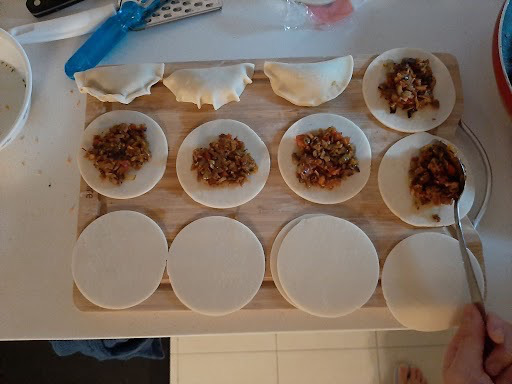
I was feeling lazy and didn't want to wash more dishes, and since I already had a steamer, I just put the pot stickers in there.

I steamed them for 20 minutes to really cook the wrappers.
And voila!


And just serve with any choice of dipping sauce.
Honestly? It turned out better than I expected. But I think I needed to steam it a bit more since the wrapper was just a bit thick and chewy in my opinion.
Overall, pretty good 👍👍

#pot stickers#dumplings#gyoza#brad pitt#if brad pitt eats it i will to#and cook it#Ocean's 13#care to learn#spicing up my life#and my taste buds#literally its a bit spicy#vegetarian#vegetarian dumplings#vegetarian recipes#vegetarian food#vegetarian cooking#the garlic granule is a lie it was actually chili#we were all lied to#food#foodblogger#food blog#recipe blog#there is no such thing as too many tags
41 notes
·
View notes
Text
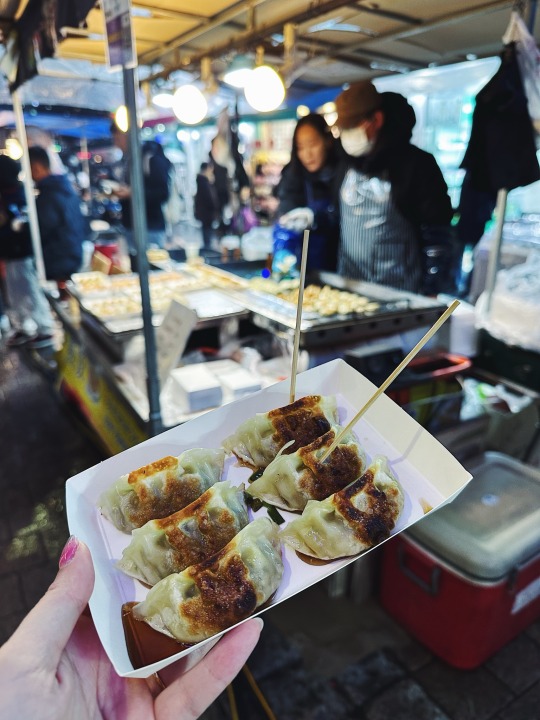
Myeongdong Night Market / Seoul, South Korea
Vegan friendly vegetable dumplings 🥟
#vegan#veganism#what vegans eat#vegan food#vegan eats#vegan friendly#vegan travel#myeongdong#Seoul#South Korea#vegan Seoul#myeongdong night market#night market#vegetarian dumplings#steamed dumplings#dumplings#dumpling#photo dump#travel#travel food#travelling#서울#비간
17 notes
·
View notes
Photo
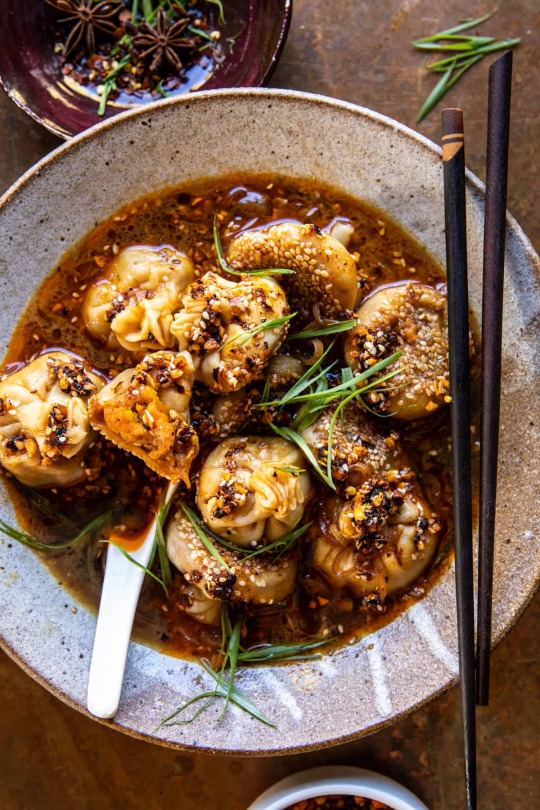
Chili crisp butternut squash dumplings in ginger soy broth
#dumplings#butternut squash#chinese food#dinner#food#chinese cuisine#asian food#dumpling soup#soy sauce#vegetarian#vegan#chili crisp#chili garlic#meal#foodporn#delicious#cooking#food photography#foodgasm#recipe
2K notes
·
View notes
Text
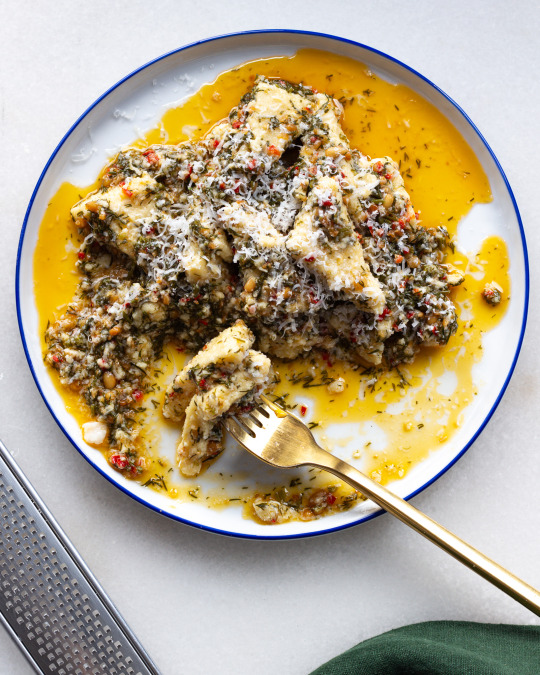
Feta Dumplings with Pine Nut Fresno Sauce
#food#recipe#dinner#gnudi#dumplings#cheese#feta#ricotta#garlic#pine nuts#dill#vinegar#peppers#vegetarian
69 notes
·
View notes
Photo

3 Best Dumpling Recipes (Chicken, Vegetarian, Pork)
#dumpling#dumplings#chicken#meat#poultry#pork#vegetable#vegetables#vegetarian#vegetarian recipe#vegetarian recipes#miscellaneous#miscellaneous recipes
483 notes
·
View notes
Text

[ID: Five large, enclosed bao piled on a plate. The topmost bao has been opened to show a bread-like dough texture and a vegetable filling. The bao are garnished with chopped chives. End ID]
Bánh bao chay (Vietnamese vegetable dumplings)
Bánh bao are an iteration on the Chinese da bao (大包) brought to Vietnam by Cantonese immigrants. Like da bao, bánh bao are commonly filled with some combination of minced meat, Chinese sausage, and hard-boiled eggs; however, some versions of bánh bao are also made with Vietnamese vegetables, herbs, and flavorings. Vegetarian bánh bao (bánh bao chay) may have no filling, a filling consisting of a variety of vegetables, or a filling of sweetened beans or sweet potato.
This recipe combines Vietnamese vegetables, herbs, spices, and sauces with Vietnamese meat substitutes to make a well-rounded filling that's equal parts umami and fresh. The yeasted, enriched dough is tasty, fluffy, and light, but still has enough structure to hold up against the filling.
Recipe under the cut!
Patreon | Tip jar
Makes 16-20; serves 6.
Ingredients:
For the dough:
4 cups + 2 Tbsp (500g) all-purpose flour
2 tsp (7g) active dry yeast
7 Tbsp (90g) granulated sugar
1/2 tsp salt
2 tsp (10g) baking powder (optional)
2 Tbsp (16g) cornstarch (optional)
1 - 1 1/4 cup (135-295 mL) lukewarm soy or oat milk, or water
1 Tbsp cooking oil
The basic components of this dough are flour, yeast, sugar, salt, oil, and milk. The baking powder is added to help with leavening; the cornstarch works to create a light, fluffy dough that will not become soggy when filling is added.
For the filling:
1 large carrot (100g)
4-inch piece (120g) cassava root / yuca
1 cup (100g) shiitake or wood-ear mushrooms, diced
4 large pieces (50g) sườn non chay, or 1/2 cup diced or crumbled chả lụa chay
1/2 cup water + 1/2 tsp vegetarian 'chicken' broth concentrate (optional)
50g tofu skin (đậu hủ ky)
1 red onion, minced
5 cloves garlic, chopped
4-5 chives or scallions, finely chopped
1 tsp freshly ground black pepper
1/2 tsp sugar, or to taste
1/2 tsp salt, or to taste
2 tsp bột nêm chay, ground to a powder (optional)
1 1/2 tsp fermented bean paste + 1/2 tsp light soy sauce (or 2 tsp vegetarian fish sauce)
2 tsp vegetarian oyster sauce
1/4 cup soybean oil, peanut oil, or other cooking oil, divided
Sườn non chay (roughly, “vegetarian ribs”) is a meat replacement made of textured soy protein. It may be found in bags online or in the pantry / dried goods section at your local Asian grocery store—the bags will be labelled “sườn non chay” as well as “vegan meat slice,” “textured soy bean protein,” “vegetarian food,” or “vegan food.” Most sườn non chay are large and pale in color, but they sometimes come in "beef" or "pork" styles—the difference is not the flavoring but rather the size, shape, and coloring of the pieces. In my experience, the "beef" ones are more darkly colored, and both "beef" and "pork" styles are smaller in size and thinner in shape than the non-specific ones, which I often use to replace chicken.
Chả lụa chay is a vegetarian version of a Vietnamese pork sausage. It can be found in the form of a large loaf in the refrigerator section of a Vietnamese or Asian grocery store. It will be labelled "chả lụa chay" or "gio lụa chay," as well as "vegetarian pork roll," "wheat meat," or "vegetarian food."
Đậu hủ ky, or tofu skin, is prepared by taking the film off of a batch of tofu as it sets. Tofu skin may be purchased fresh or dried, in sheets or in sticks: for the purposes of this recipe, any kind will work! Chinese tofu skin produced for sale abroad may be labelled "dried beancurd sticks."
Bột nêm is a Vietnamese seasoning sold in powder or granule form. Vegetarian ("chay") versions of the seasoning may contain shiitake mushroom, lotus seeds, carrots, tomatoes, and kohlrabi, as well as salt and MSG. It can be purchased in pouches or boxes from an Asian grocery store, or you can use any other vegetable stock powder.
Fish sauce and oyster sauce are common inclusions in pork fillings for bánh bao but are often simply omitted from vegetarian ones. I've used vegetarian substitutes for these ingredients—if you don't have vegetarian imitation fish or oyster sauce, just increase the amount of salt, sugar, and bột nêm to taste.
Instructions:
For the dough:
1. Heat 1 cup (135mL) non-dairy milk to lukewarm in a saucepan or in the microwave. Stir in the yeast to dissolve. if you’re not sure your yeast is alive, proof it by allowing to stand for 10 minutes—it should foam.
2. Add the baking powder, sugar, and salt and whisk to dissolve.
3. In a large bowl, whisk together flour and cornstarch. Pour in the milk mixture and mix well to combine. Add additional milk 1 tsp at a time if it remains too dry to combine. The dough should be slightly tacky but not sticky.
3. Add oil and knead by hand until dough is smooth and elastic, about 10 minutes. Cover with plastic wrap and allow to rise in a warm place for about 3 hours until doubled in size. If you live in a cold climate and don't have a proofing drawer, heat your oven on the lowest setting for a few minutes, turn it off, and then proof the dough in the oven.
For the filling:
1. Prepare the proteins. Soak the tofu skin (if you're using dried) and sườn non chay in cool water for about half an hour until rehydrated (or simmer them for a shorter amount of time). They are fully hydrated once flexible and a couple shades lighter. Gently squeeze the water out. Dice tofu skin; rip sườn non chay into small pieces lengthwise and then dice widthwise.
2. Prepare the vegetables. Peel cassava root and carrot. Cut both into a fine julienne, or grate them. Dice the mushrooms; mince the red onion; chop the garlic.


3. Cook the filling. Heat oil in a large skillet on medium. Add the garlic and sauté until fragrant.
4. Add the red onion and continue to sauté until fragrant and slightly softened. Add black pepper, bột nêm, and salt and allow to cook another 30 seconds.
5. Add carrot, cassava, mushrooms, chả lụa chay (if using), and tofu skin and stir to combine. Reduce heat to low and cook, stirring often, until tender. Remove from pan.
6. If using sườn non chay: in the same pan, fry sườn non chay in 3 Tbsp of cooking oil on medium until they’ve absorbed the oil. Whisk 'chicken' stock concentrate into a small amount of hot water, then add the stock into the pan. Cook until mostly dry.
Soaking in water, deep frying in oil, then simmering in a flavored broth is the typical Vietnamese preparation of sườn non chay. The simmering in stock could potentially be skipped if you're including vegetarian oyster and/or fish sauce, but personally I find that dried soy products benefit from being soaked or simmered in something other than water.
7. Mix sườn non chay in with other filling ingredients, salt, sugar, sauces, and chives.
To assemble:
1. Turn dough out from its proofing bowl and gently divide into two even parts. Cover the half you're not using and gently roll the other out into a log of even width. Use a dough cutter or sharp knife to divide the log into 8 or 10 even pieces.
2. Place each disc of dough on its side and roll it out into a circle about 5" (13cm) in diameter. The edges of the circle should be much thinner than the center, since the edges will be bundled up and folded together.
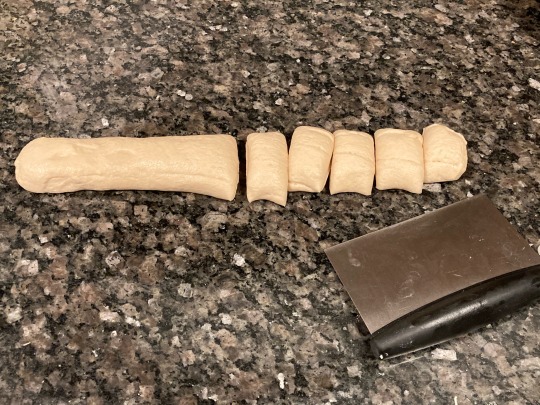
3. The folding method is the same as for baozi and momos. Hold a wrapper in the palm of your non-dominant hand and add a couple tablespoons of filling (if you’re not experienced with making dumplings, it may be easier to add less). While pressing the filling down with your non-dominant thumb, use your other hand to pinch pleated folds in the dough all the way around the circle of the wrapper. Remove your thumb and make one last fold to close the bao. Pinch firmly at the place where all the pleats come together (where the drawstring would be if it were a drawstring pouch) and give a small twist to seal.
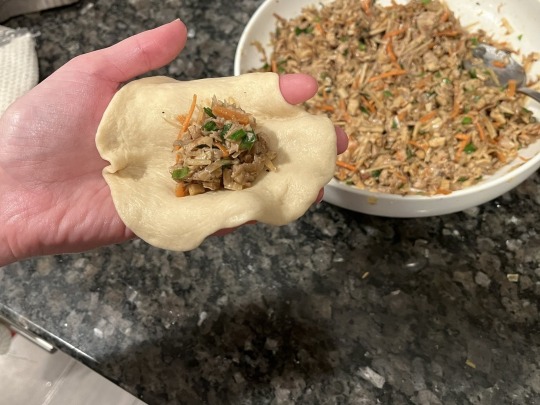
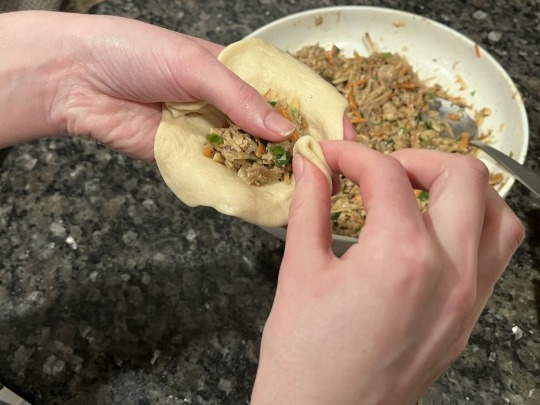
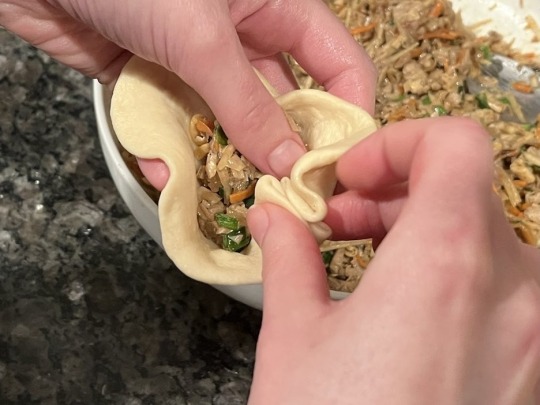


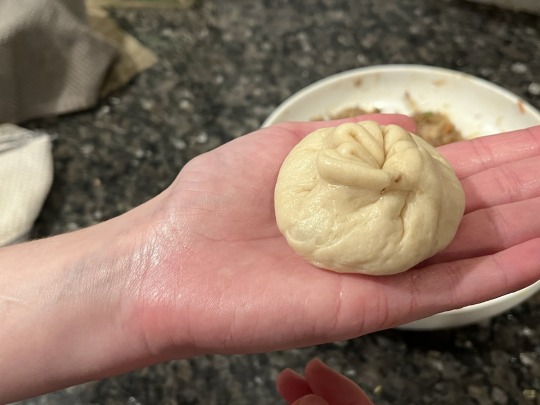
4. Set each finished bao on a small square of parchment paper on a baking sheet or in a steamer and lightly cover with plastic wrap or a light kitchen towel. Continue folding until you have formed all of the bao.
To steam:
1. Place a bamboo steamer in the bottom of a wok or large pot, and fill the wok with enough cool water to cover the bottom rim of the steamer by ½". If you've added baking powder to your dough, you may add a splash of vinegar to the water to help neutralise the dough's pH and combat yellowing of the dough.
If you’re using a metal steamer, tie a kitchen towel around its lid to prevent condensation from dipping back down onto the dumplings. Carefully place the bao, along with their parchment paper squares, into the steamer, leaving an inch or so between each one. They will expand as they steam!
If you don’t have a steamer, place a small bowl in the bottom of a wok or large, deep pan or pot. Place the dumplings, with their parchment paper squares, on a plate and place the plate on top of the bowl–the plate should fit inside your pot. Make sure that you can cover the plate and dumplings with a lid. If your lid is domed, there is no need for a kitchen towel, since the condensation will run down towards the outer rim. If your lid is flat, tie a tea towel around it just as you would with a metal steamer. Fill your cooking vessel with 2 or so centimeters of cool water.
2. Raise the heat to high and allow the water to come to a boil. Once boiling, lower the heat to medium-low and cover your steamer or pot. Steam the dumplings for about 8 minutes, until the dough is tender and cooked through. Keep finished bao warm in a covered casserole dish in an oven on low while you steam the others.
#vegetarian recipes#recipes#vegan recipes#Vietnamese#dumplings#carrots#cassava root#tofu skin#mushrooms#sườn non chay#chả lụa chay#fish sauce#chives
235 notes
·
View notes
Text

Vegetable Egg Rolls (素春卷)
These vegetable egg rolls combine the pleasant crunch of the fried shell with the freshness of the garden.
Recipe => https://omnivorescookbook.com/vegetable-egg-rolls/
52 notes
·
View notes
Text

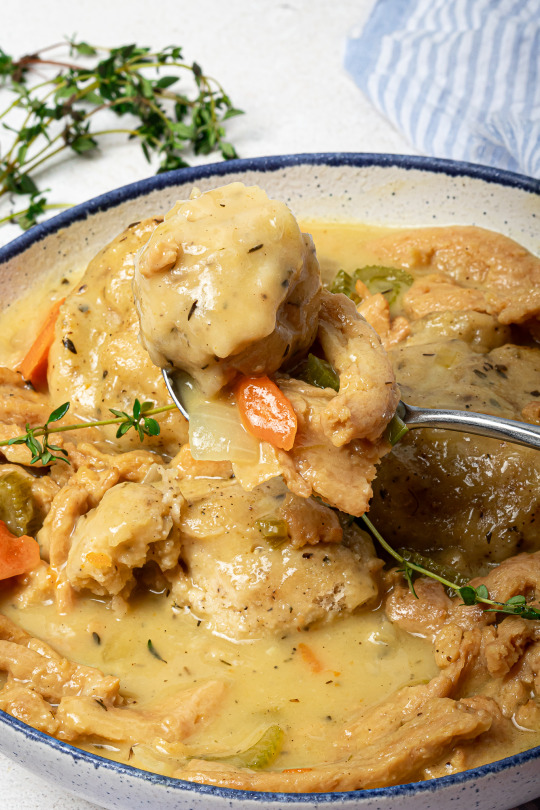
Vegan Chicken and Dumplings
#vegan#food#vegetarian#vegan food#veganism#recipe#plantbased#vegan recipe#dinner#vegan soup#dumplings
38 notes
·
View notes
Photo




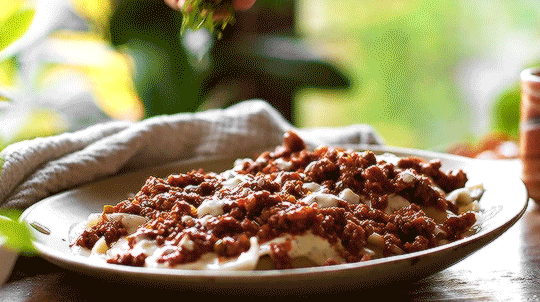
an afghan feast » what i ate growing up 🇦🇫 — AUSHAK
#food#foodedit#food gifs#recipes#vegan#vegetarian#cooking#plant based#plant based recipes#vegan recipes#afghan cuisine#afghan recipes#aushak#dumplings#sadia badiel#pick up limes#youtube#mine#gifs
543 notes
·
View notes
Text

Barszcz'd successfully 😎
14 notes
·
View notes
Text

Daom Vegetarian / Seoul, South Korea
Traditional Korean noodles (잔치국수) and dumpling soup with rice cakes (떡민두국)
#vegan#veganism#what vegans eat#vegan food#vegan eats#vegan travel#vegan friendly#Seoul#South Korea#dumpling soup#vegetarian dumplings#steamed dumplings#dumpling#dumplings#noodles#traditional#home made#vegan Seoul#서울#비간#daom vegetarian
2 notes
·
View notes
Text
sure would like to have some delicious vegetarian dumplings for lunch. unfortunately that would mean Doing Research and Spending Money. what a terrible world we live in where this is the case
16 notes
·
View notes
Photo

Half-Baked Harvest: Chili Crisp Butternut Squash Dumplings in Ginger Soy Broth
I made this today and unfortunately was a little let down by it! And it was a time-intensive ordeal, for sure. I made two modifications, which I don’t think much influenced the turn-out and, in fact, probably made it better...: I used sweet potato instead of butternut squash for the filling and substituted sake and rice wine vinegar for the white wine.
If I made it again, I would:
Leave out the curry powder (not sure what that’s doing in there! It doesn’t match the flavor of the broth very well, imo) and maybe use a different filling entirely (mushrooms might work well)
Make my own chili crisp since the one I bought was super salty, albeit tasty, OR cut salt elsewhere in the recipe
I made the unfortunate mistake of using regular chicken broth instead of low sodium broth, so even though I diluted it ~25% with water, it was very salty in combination with the soy sauce and chili crisp. Note that the recipe also called for salted butter and regular soy sauce (I used unsalted and low sodium, respectively), so I can’t imagine it being all that different if I’d followed the recipe.
I would try using thinner dumpling wrappers, which would cook faster than the ones I used. Mine took about 5 mins to steam, which ended up softening the nice sesame crust on the bottoms. I was also afraid of burning the sesame seeds, so I didn’t fry the dumplings for very long before steaming. I might recommend leaving the sesame seeds off and sprinkling on some as a garnish (since they fall off when frying, anyway).
That’s my long-ass take on how I would make this recipe better! I’m trying to continue keeping track of what I cook and what changes I would make in order to keep this blog useful and organized. One of my goals this year is to meal plan and cook ahead more often, and I’ve done well with it so far this week (Lemon, it’s Tuesday! Yeah, I know).
Lastly, not to be too salty (BAD pun, sorry) this early in the new year, but I’ve yet to find a Half-Baked Harvest recipe that doesn’t require heavy modification. I don’t know why they’re all so popular and well-rated! Teighan seems great, but we must have different tastes or methods of cooking.... This is at least the third one I can think of off the top of my head that I’ve tried and disliked.
#japanese#vegan#vegetarian#dumplings#sweet potato#butternut squash#ginger#soup#asian#main dish#food#recipe#obvs only veg with modifications (mentioned in recipe)#made this!
31 notes
·
View notes
Text

Vegan Teochew Crystal Dumplings
#food#recipe#dim sum#crystal dumplings#dumplings#fun guo#tofu#mushrooms#carrots#peanut#radish#vegetarian#vegan#dairy free#chinese#breakfast
108 notes
·
View notes
Text
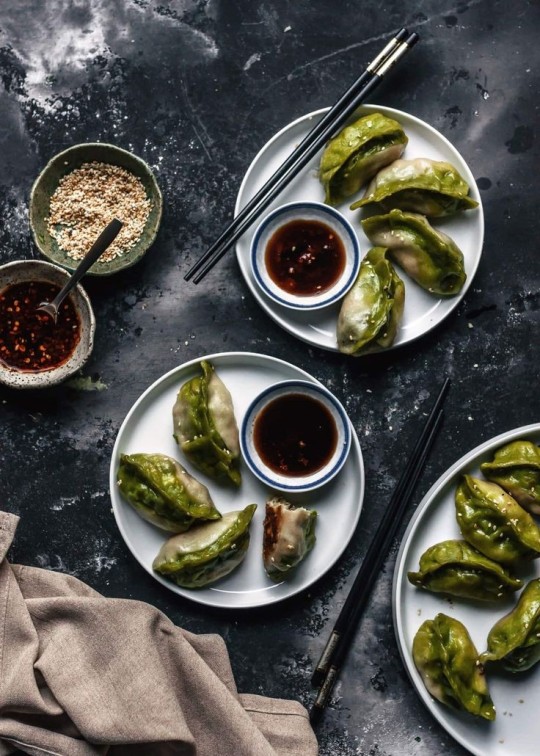
Pan-Fried Bok Choy Dumplings
65 notes
·
View notes
Text

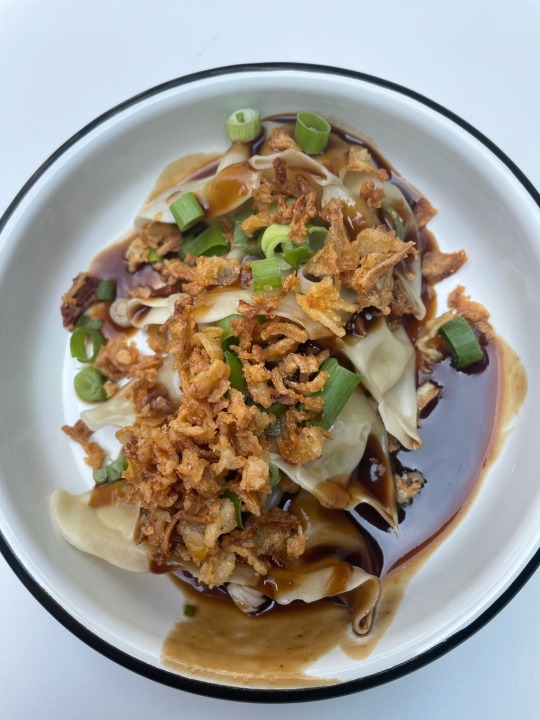
delicious vegan bao and dumplings. love me some fried onions😋
Lil Bao- Brussels, Belgium 🇧🇪
#vegan#veganism#go vegan#be vegan#veg#vegan dinner#bao#dumplings#veggies#vegetables#vegetarian#belgium#brussels#vegan in belgium#vegan in brussels#bao buns#onion#tofu#meatless#vegan meat#meat free
5 notes
·
View notes